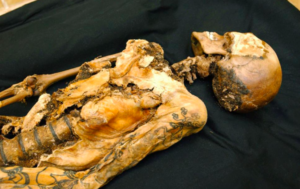
It happened in Chicago, where conservators opened the tomb of the 2,500-year-old mummy for the first time to prepare it for an exhibit.
“It’s quite nervous-making,” conservator JP Brown told the Guardian, of the experience his team had trying to safely remove the mummy. “And it makes one more nervous when one is working with human remains and as they get younger it gets more affecting. You realize this was a person’s life that was cut short.”
Brown will work with with three other scientists at the Chicago Field Museum to repair any damage to the coffin and prepare the body to be a part of “Mummies: Images of the Afterlife.”
The exhibit that will showcase more than 20 mummies is expected to travel to the Natural History Museum of Los Angeles and Denver Museum of Nature and Science.
The body belonged to Minirdis, a 14-year-old Egyptian boy who is thought to be the son of a priest of Min, an Egyptian fertility god, due to an inscription on his tomb. His tomb was found in the late 19th century in the Akhmim cemetery, on the east side of the Nile in Upper Egypt and was acquired by Chicago’s Field Museum in 1925.
Moving the artifact did not come without complication.
“If you took a jigsaw puzzle and twisted it and tore it and then left it for 2,300 years, that’s basically what we’re doing here,” Brown told the Guardian.
“The shroud, placed under the mask, but above the main wrappings, had been dragged to one side, carrying a painted cartonnage collar down under the mummy and this made removing the mummy quite difficult,” Brown said. “The linen of the shroud and wrappings was quite brittle and this further complicated the operation.”
The conservators plan to save as much of the original material as possible to protect the integrity of the piece when making repairs.
“Each object is effectively unique,” Brown said, with “all kinds of different traditions of craftsmanship that evolve over thousands of years”.
The biggest task will be reattaching Minirdis’ feet.
“We will attempt to close up the wrappings at the toes. The linen wrappings are quite brittle, so it is a difficult task,” Brown said.


